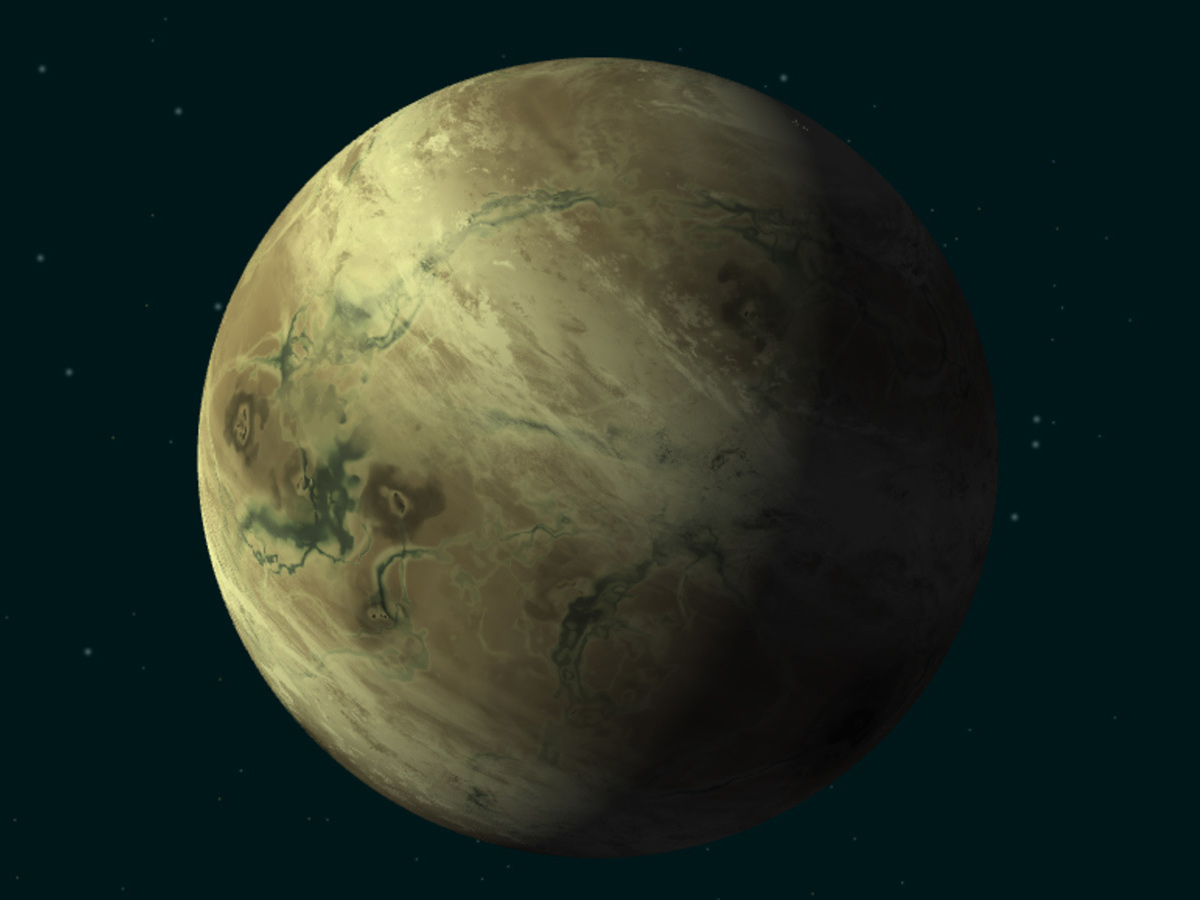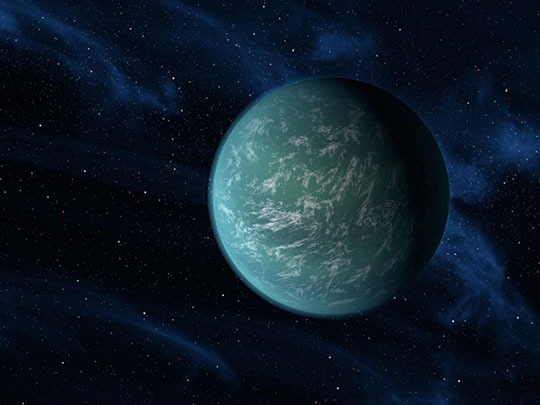Super-Earth Basics
Super-Earths – a class of planets unlike any in our solar system – are more massive than Earth yet lighter than ice giants like Neptune and Uranus, and can be made of gas, rock or a combination of both. They are between twice the size of Earth and up to 10 times its mass.
Super-Earth is a reference only to an exoplanet’s size – larger than Earth and smaller than Neptune – but not suggesting they are necessarily similar to our home planet. The true nature of these planets remains shrouded in uncertainty because we have nothing like them in our own solar system – and yet, they are common among planets found so far in our galaxy.
Over the last three decades, we have discovered all kinds of strange planets we never knew existed and that have no analog in our solar system. Super-Earths can be up to 10 times more massive than Earth. We don’t yet know enough about these planets to tell at what point they might lose a rocky surface. But in the range of 3-10 times the mass of Earth, there might be a wide variety of planetary compositions, including water worlds, snowball planets, or planets that, like Neptune, are composed largely of dense gas. Exoplanets at the upper limits of the super-Earth size limit can also be referred to as sub-Neptunes, or mini-Neptunes.
5 Key Super-Earth Planet Facts
(with artists' concepts of these alien worlds)
 5 Key Super-Earth Planet Facts: There's a super-Earth exoplanet with temperatures hot enough to vaporize metal.01
5 Key Super-Earth Planet Facts: There's a super-Earth exoplanet with temperatures hot enough to vaporize metal.01Super hot super-Earth
There's a super-Earth exoplanet with temperatures hot enough to vaporize metal.
 5 Key Super-Earth Planet Facts: Kepler-452b was the first Earth-size planet discovered around a near solar twin.02
5 Key Super-Earth Planet Facts: Kepler-452b was the first Earth-size planet discovered around a near solar twin.02A star like our Sun
Kepler-452b was the first Earth-size planet discovered around a near solar twin.
 03
03 5 Key Super-Earth Planet Facts: A super-Earth planet could be hiding at the edge of our own solar system.04
5 Key Super-Earth Planet Facts: A super-Earth planet could be hiding at the edge of our own solar system.04Closer to home
A super-Earth planet could be hiding at the edge of our own solar system.
 The nearest single star to the Sun hosts an exoplanet at least 3.2 times as massive as Earth — a so-called super-Earth. Data from a worldwide array of telescopes, including ESO’s planet-hunting HARPS instrument, have revealed this frozen, dimly lit world. The newly discovered planet is the second-closest known exoplanet to the Earth and orbits the fastest moving star in the night sky.. This image shows an artist’s impression of the exoplanet viewed from space.ESO/M. Kornmesser05
The nearest single star to the Sun hosts an exoplanet at least 3.2 times as massive as Earth — a so-called super-Earth. Data from a worldwide array of telescopes, including ESO’s planet-hunting HARPS instrument, have revealed this frozen, dimly lit world. The newly discovered planet is the second-closest known exoplanet to the Earth and orbits the fastest moving star in the night sky.. This image shows an artist’s impression of the exoplanet viewed from space.ESO/M. Kornmesser05Frozen neighbor
A dim, frozen super-Earth orbits a fast-moving star just 6 light-years away.
Super-Earths and mini-Neptunes
In 2019, NASA’s Transiting Exoplanet Survey Satellite (TESS) discovered a super-Earth and two mini-Neptunes orbiting a faint, cool star about 73 light-years away in the southern constellation of Pictor. The M-type dwarf star is about 40% smaller than the Sun in both size and mass, and it has a surface temperature about one-third cooler than the Sun’s.
The innermost planet, TOI 270 b, is likely a rocky super-Earth about 25% larger than Earth. It orbits the star every 3.4 days at a distance about 13 times closer than Mercury orbits the Sun. Based on statistical studies of known exoplanets of similar size, the science team estimates TOI 270 b has a mass around 1.9 times greater than Earth’s.
The other two planets, TOI 270 c and d, are, respectively, 2.4 and 2.1 times larger than Earth and orbit the star every 5.7 and 11.4 days. Although only about half its size, both may be similar to Neptune in our solar system, with compositions dominated by gases rather than rock, and they likely weigh around 7 and 5 times Earth’s mass, respectively, making them mini-Neptunes.

Researchers hope further exploration of the star, TOI 270, may help explain how two of these mini-Neptunes formed alongside a nearly Earth-size world. Further research may reveal additional planets in the system. If planet d has a rocky core covered by a thick atmosphere, its surface would be too warm for the presence of liquid water, considered a key requirement for a potentially habitable world. But follow-up studies may discover additional rocky planets at slightly greater distances from the star, where cooler temperatures could allow liquid water to pool on their surfaces.
Climate patterns of a super-Earth
Observations from NASA's Spitzer Space Telescope led to the first temperature map of a super-Earth in 2016. The map reveals extreme temperature swings from one side of the planet to the other, and hints at a reason for this: lava flows.
The toasty super-Earth 55 Cancri e is relatively close to Earth at 41 light-years away. It orbits very close to its star, whipping around it every 18 hours. Because of the planet's proximity to the star, it is tidally locked by gravity just as our Moon is to Earth. That means one side of 55 Cancri, referred to as the day side, is always cooking under the intense heat of its star, while the night side remains in the dark and is much cooler.
Spitzer stared at the planet with its infrared vision for a total of 80 hours, watching it orbit its star multiple times. These data allowed scientists to map temperature changes across the entire world. To their surprise, they found a dramatic temperature difference of 2,340 degrees Fahrenheit (1,300 Kelvin) from one side of the planet to the other. The hottest side is nearly 4,400 degrees Fahrenheit (2,700 Kelvin), and the coolest is 2,060 degrees Fahrenheit (1,400 Kelvin).
Explore the planet types: Gas Giant, Neptune-like, Super-Earth and Terrestrial
Or move on to the building blocks of galaxies: stars!
More to Explore

Where the Grass is Always Redder
Kepler-186f is the first Earth-size planet discovered in the potentially 'habitable zone' around another star, where liquid water could exist on the planet's surface. Its star is much cooler and redder than our Sun. If plant life does exist on a planet like Kepler-186f, its photosynthesis could have been influenced by the star's red-wavelength photons, making for a color palette that's very different than the greens on Earth. This discovery was made by Kepler, NASA's planet hunting telescope.

55 Cancri e: Skies Sparkle Above a Never-Ending Ocean of Lava
Planet Janssen, or 55 Cancri e, orbits a star called Copernicus only 41 light years away.

Kepler-186f Coloring Page
What tones will you pick to color Kepler-186f? Grab crayons, markers, paint or colored pencils and color in the coloring page based on our popular Exoplanet Travel Bureau poster for the planet with a red sun.

Exoplanet Types Infographic
Exoplanets, planets beyond our solar system, whether orbiting other stars or floating freely between them, can make the planets closer to home look tame by comparison.





